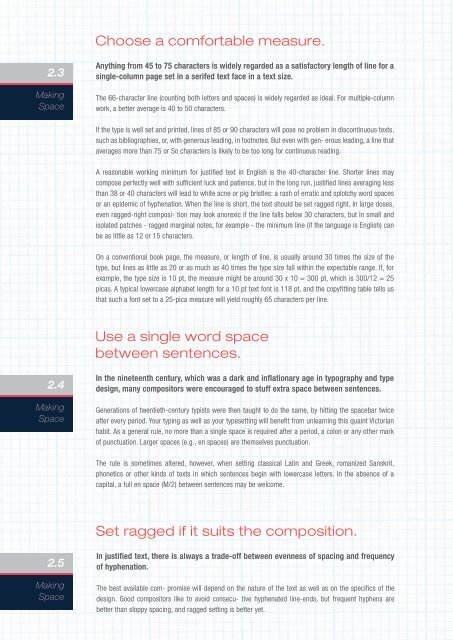5 Trick Pony Brand Guidelines v3
You also want an ePaper? Increase the reach of your titles
YUMPU automatically turns print PDFs into web optimized ePapers that Google loves.
Choose a comfortable measure.<br />
2.3<br />
Making<br />
Space<br />
Anything from 45 to 75 characters is widely regarded as a satisfactory length of line for a<br />
single-column page set in a serifed text face in a text size.<br />
The 66-character line (counting both letters and spaces) is widely regarded as ideal. For multiple-column<br />
work, a better average is 40 to 50 characters.<br />
If the type is well set and printed, lines of 85 or 90 characters will pose no problem in discontinuous texts,<br />
such as bibliographies, or, with generous leading, in footnotes. But even with gen- erous leading, a line that<br />
averages more than 75 or So characters is likely to be too long for continuous reading.<br />
A reasonable working minimum for justified text in English is the 40-character line. Shorter lines may<br />
compose perfectly well with sufficient luck and patience, but in the long run, justified lines averaging less<br />
than 38 or 40 characters will lead to white acne or pig bristles: a rash of erratic and splotchy word spaces<br />
or an epidemic of hyphenation. When the line is short, the text should be set ragged right. In large doses,<br />
even ragged-right composi- tion may look anorexic if the line falls below 30 characters, but in small and<br />
isolated patches - ragged marginal notes, for example - the minimum line (if the language is English) can<br />
be as little as 12 or 15 characters.<br />
On a conventional book page, the measure, or length of line, is usually around 30 times the size of the<br />
type, but lines as little as 20 or as much as 40 times the type size fall within the expectable range. If, for<br />
example, the type size is 10 pt, the measure might be around 30 x 10 = 300 pt, which is 300/12 = 25<br />
picas. A typical lowercase alphabet length for a 10 pt text font is 118 pt, and the copyfitting table tells us<br />
that such a font set to a 25-pica measure will yield roughly 65 characters per line.<br />
Use a single word space<br />
between sentences.<br />
2.4<br />
Making<br />
Space<br />
In the nineteenth century, which was a dark and inflationary age in typography and type<br />
design, many compositors were encouraged to stuff extra space between sentences.<br />
Generations of twentieth-century typists were then taught to do the same, by hitting the spacebar twice<br />
after every period. Your typing as well as your typesetting will benefit from unlearning this quaint Victorian<br />
habit. As a general rule, no more than a single space is required after a period, a colon or any other mark<br />
of punctuation. Larger spaces (e.g., en spaces) are themselves punctuation.<br />
The rule is sometimes altered, however, when setting classical Latin and Greek, romanized Sanskrit,<br />
phonetics or other kinds of texts in which sentences begin with lowercase letters. In the absence of a<br />
capital, a full en space (M/2) between sentences may be welcome.<br />
Set ragged if it suits the composition.<br />
2.5<br />
Making<br />
Space<br />
In justified text, there is always a trade-off between evenness of spacing and frequency<br />
of hyphenation.<br />
The best available com- promise will depend on the nature of the text as well as on the specifics of the<br />
design. Good compositors like to avoid consecu- tive hyphenated line-ends, but frequent hyphens are<br />
better than sloppy spacing, and ragged setting is better yet.





